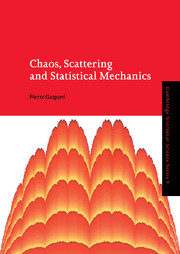Book contents
- Frontmatter
- Contents
- Preface
- Introduction
- Chapter 1 Dynamical systems and their linear stability
- Chapter 2 Topological chaos
- Chapter 3 Liouvillian dynamics
- Chapter 4 Probabilistic chaos
- Chapter 5 Chaotic scattering
- Chapter 6 Scattering theory of transport
- Chapter 7 Hydrodynamic modes of diffusion
- Chapter 8 Systems maintained out of equilibrium
- Chapter 9 Noises as microscopic chaos
- Chapter 10 Conclusions and perspectives
- References
- Index
Chapter 8 - Systems maintained out of equilibrium
Published online by Cambridge University Press: 30 January 2010
- Frontmatter
- Contents
- Preface
- Introduction
- Chapter 1 Dynamical systems and their linear stability
- Chapter 2 Topological chaos
- Chapter 3 Liouvillian dynamics
- Chapter 4 Probabilistic chaos
- Chapter 5 Chaotic scattering
- Chapter 6 Scattering theory of transport
- Chapter 7 Hydrodynamic modes of diffusion
- Chapter 8 Systems maintained out of equilibrium
- Chapter 9 Noises as microscopic chaos
- Chapter 10 Conclusions and perspectives
- References
- Index
Summary
Nonequilibrium systems in Liouvillian dynamics
Most systems in nature are maintained out of equilibrium either by incident fluxes of particles or by external fields. The earth bathed by sunlight1 is an illustration of such out-of-equilibrium systems. From this viewpoint, the systems may be considered as subjected to some scattering processes, which leads us to the scattering theory of transport of Chapter 6. In this context, the fact that most classical scattering processes are chaotic has important consequences in our understanding of nonequilibrium states and the methods of the previous chapters are thus required for the investigation of out-of-equilibrium systems.
Works on out-of-equilibrium systems have revealed that such systems remain in a thermodynamic state which is the continuation of the equilibrium state under weak nonequilibrium constraints. Beyond a certain threshold, the thermodynamic branch becomes unstable and new states emerge by bifurcation with spatial or temporal inhomogeneities, called dissipative structures (Prigogine 1961; Glansdorff and Prigogine 1971; Nicolis and Prigogine 1977, 1989). Turing structures in reaction–diffusion systems and convection rolls in fluids are examples of such nonequilibrium structures (DeWit et al. 1992, 1993, 1996; Cross and Hohenberg 1993). The transitions to dissipative structures appear sharp from a macroscopic viewpoint which ignores the thermodynamic fluctuations due to the atomic structure of matter. These fluctuations can be modelled by stochastic dynamical systems like Langevin processes, birth-and-death processes, or lattice-gas automata, which show that transitions may be rounded in systems with finitely many particles (Nicolis and Malek Mansour 1978, Malek Mansour et al. 1981, Dab et al. 1991, Lawniczak et al. 1991, Kapral et al. 1992, Baras and Malek Mansour 1997).
- Type
- Chapter
- Information
- Chaos, Scattering and Statistical Mechanics , pp. 343 - 386Publisher: Cambridge University PressPrint publication year: 1998

